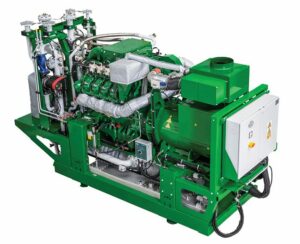Combined Heat and Power (CCHP) Systems: How They Work, Benefits for the UK, Energy Issues, and Solutions for Using Green Gas Powered Mini Substations
What is CHP?
Combined heat and power (CHP), also known as cogeneration, is a highly efficient way to generate electricity and heat from a single fuel source. CHP systems typically use natural gas, but they can also use other fuels such as biogas, biomass, and solar thermal energy.
How does CHP work?
In a CHP system, the fuel is burned to generate electricity. The heat produced by the combustion process is then captured and used to provide hot water or steam for heating, cooling, and industrial processes.
CHP systems offer a number of benefits for the UK, including:
Reduced energy costs: CHP systems can be up to 40% more efficient than traditional methods of generating electricity and heat separately. This can lead to significant savings on energy costs for businesses and organisations.
Reduced carbon emissions: CHP systems can reduce carbon emissions by up to 30% compared to traditional methods of generating electricity and heat separately. This is because CHP systems capture and use the heat that would otherwise be wasted in conventional power generation.
Improved energy security: CHP systems can help to improve the UK’s energy security by reducing its reliance on imported electricity. CHP systems can also be used to provide backup power in the event of a grid outage.

The UK faces a number of energy challenges, including:
Rising energy costs: Energy costs have been rising steadily in recent years, putting a strain on businesses and households.
Climate change: The UK has committed to reducing its carbon emissions by 78% by 2050. CHP systems can play a significant role in helping the UK to achieve this target.
Energy security: The UK is becoming increasingly reliant on imported electricity. This makes the UK vulnerable to energy price shocks and supply disruptions.
Solutions for using green gas powered mini substations
Green gas powered mini substations offer a number of potential solutions to the UK’s energy challenges. CHP systems can be used to generate electricity and heat from green gas, such as biomethane and renewable hydrogen. This can help to reduce the UK’s reliance on fossil fuels and improve its energy security.
Green gas powered mini substations can also be used to provide distributed energy generation. This means that electricity and heat can be generated closer to where it is needed, reducing the need for long-distance transmission and distribution. This can help to improve the efficiency of the energy system and reduce energy costs.
CHP systems offer a number of benefits for the UK, including reduced energy costs, reduced carbon emissions, and improved energy security. Green gas powered mini substations offer a potential solution to the UK’s energy challenges by providing distributed energy generation from a low-carbon source.

How to get started with CHP
If you are interested in learning more about CHP or installing a CHP system, there are a number of resources available. The Combined Heat and Power Association (CHPA) is a good place to start. The CHPA website provides information on the benefits of CHP, how CHP works, and how to find a CHP supplier.
The UK government also offers a number of financial incentives to support the installation of CHP systems. These incentives include the Enhanced Capital Allowance (ECA) and the Feed-in Tariff (FiT).
If you are considering installing a CHP system, it is important to consult with a qualified CHP engineer to ensure that the system is the right size for your needs and that it is installed correctly.
CHP systems are a versatile technology that can be used in a wide range of applications, including:
- Commercial buildings, such as hotels, hospitals, and office blocks
- Industrial facilities, such as food processing plants and manufacturing plants
- Residential developments, such as district heating schemes and new housing estates
As the UK transitions to a low-carbon economy, CHP systems will play an increasingly important role in meeting the country’s energy needs. Green gas powered mini substations offer a particularly promising solution for distributed energy generation from a low-carbon source. CHP systems can also be used to provide power and heat for remote communities and off-grid applications.

